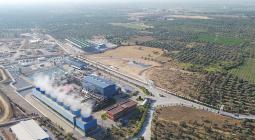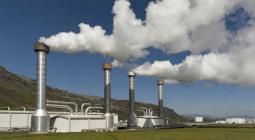Green electricity from heat under the sea – Offshore geothermal energy.

Scientists from Iceland and oil nation Norway want to help the world to generate electricity from offshore geothermal heat sources – a process that causes no CO2 emissions or conflicts about landscape destruction.
Scientists from Iceland and oil nation Norway want to help the world to generate electricity from offshore geothermal heat sources – a process that causes no CO2emissions or conflicts about landscape destruction.
The uppermost layers of the Earth’s crust contain incredible volumes of renewable heat. So much indeed that just a small fraction of this heat is sufficient to meet the planet’s entire energy needs. Geothermal heat is all around us and can in principle be exploited by everyone – although the truth in this last statement requires some qualification.
The heat currently being extracted from the ground beneath our gardens and utilised in heat pumps is in fact mainly derived from the sun. Real geothermal heat is found somewhat deeper down – where the temperature increases for every metre we descend.
Geothermal heat is most easily accessible where tectonic plates meet, such as in Iceland. Because it is here that the Earth’s crust is thinnest. It is thus also in such places that it is easier to extract heat at temperatures high enough to generate electricity. In Iceland, and in countries such as the Philippines, New Zealand and Costa Rica, onshore geothermal heat plants for electricity generation make a real difference on a domestic scale.
However, because development has until now been limited to onshore heat sources, not all plans for such plants become a reality. In order to be profitable, such plants must be of a given size. For this reason, many future development projects risk running up against opposition of the same kind now encountered by wind farm developers in Norway. It is in the light of this that a new collaboration project has been initiated between researchers across the Norwegian Sea.
The idea is to utilise Iceland’s know-how in the field of geothermal heat, combined with Norwegian expertise in offshore oil production, with the aim of developing an offshore-based system for the production of geothermal heat. Given their natural resources, many parts of the world are well positioned to benefit from such systems.
The collaboration is the result of licences recently awarded to the Icelandic energy company North Tech Energy (NTE) for research into two high-temperature areas on the Icelandic continental shelf.
With these licences as a starting point, we at NTE and SINTEF have prepared plans for a major research project. Joining our team is the Icelandic consulting and research company Iceland Geosurvey (ÍSOR). The objective is to develop a beacon project that other parts of the world can use as a guide.
Our dream is to demonstrate an operative power plant installed on a jack-up platform on the Icelandic continental shelf, equipped with steam turbines that will generate large volumes of electricity from scorching geothermal steam. The product – renewable and CO2-free electricity – will be transferred in subsea cables to customers in the rest of Europe.
By combining expertise from Iceland and Norway, we shall first identify suitable methods for carrying out the seabed surveys that are necessary to identify possible production sites in the two licence areas.
The next objective is to establish a research collaboration that can lead to the cost-effective development and operation of an offshore geothermal power plant. Here too, Norway’s expertise in offshore oil production will be key. Everything from offshore-related materials technology to know-how about maritime operations.
We are fully aware that it is usually more expensive to develop geothermal fields offshore than on land. That we nevertheless have faith in the feasibility of offshore power plants is because everything from housing developments to conservation areas make geothermal power plants impossible to build in many locations onshore.
Moreover, some onshore geothermal fields are so inaccessible that they are more difficult to develop than offshore fields. Thus, in some situations, offshore geothermal plants may be less expensive to develop than onshore facilities. However, most important is that offshore plants will probably encounter less opposition among the general public because they are less of an eyesore and much smaller than onshore plants.
Geothermal energy originates from two sources – residual heat from the formation of the Earth, and processes that are continuously breaking down radioactive substances in the Earth’s crust. The energy is extracted by pumping cold water to depth using an injection well and then retrieving it at higher temperatures using a production well. At depth, between the wells, water flows through fractures where it is heated.
Electricity generated from offshore geothermal plants may be of interest to countries other than Iceland, including Portugal, Italy, the Philippines, Indonesia, Japan and Russia, as well as countries in Central America and the Caribbean.
If our plans succeed, our expertise in this field could become a major Norwegian-Icelandic export commodity, helping in the battle to mitigate climate change.
Article by Geir Hagalinsson, CEO at North Tech Energy, Iceland, and Térence Coudert, Research Scientist at SINTEF
18 June 2019
THINK GEOENERGY




